This past offseason, Pitcher List introduced Pitch Level Value, or PLV, a new metric that assesses player performance by grading outcomes on the single pitch level. If you’re new to it, you can read Nick Pollack’s primer on PLV here.
You’ll find the definitions below. Grades are on a 20-80 scale.
Swing Aggression: How much more often a hitter swings at pitches, given the swing likelihoods of the pitches they face.
Strikezone Judgement: The “correctness” of a hitter’s swings and takes, using the likelihood of a pitch being a called strike (for swings) or a ball/HBP (for takes).
Decision Value (DV): Modeled value (runs per 100 pitches) of a hitter’s decision to swing or take, minus the modeled value of the alternative.
Contact Ability: A hitter’s ability to make contact (foul strike or BIP), above the contact expectation for each pitch.
Power: Modeled number of extra bases (xISO on contact) above a pitch’s expectation, for each BBE.
Hitter Performance (HP): Runs added per 100 pitches seen by the hitter (including swing/take decisions), after accounting for pitch quality.
Pitch Level Value (PLV): Estimated value of all pitches, based on the predicted outcome of those pitches (0-10, 5 is league average).
Pitch Level Average (PLA): Value of all pitches (ERA Scale), using IP and the total predicted run value of pitches thrown.
Pitch type PLA: Value of a given pitch type (ERA scale), using total predicted run values and an IP proxy for that pitch type (pitch usage % x Total IP).
(Note: All PLV data is current through Thursday, 7/20).
Coming off a 2.94 ERA and 0.97 WHIP across a career-high 202 IP, Burnes has been relatively disappointing this year. The interesting thing is that the PLV machine wasn’t really that keen on him. Burnes’ 5.09 PLV last season paled in relation to his ADP; Several top-tier arms, including Zack Wheeler (5.37), Aaron Nola (5.35), and Gerrit Cole (5.27), just to name a few, rated significantly better.
Part of the disconnect between his repute and PLV last season was his cutter; His bread and butter pitch earned a good but not fantastic 5.21 PLV / 2.88 PLA. This season, the cutter has taken a step back with a 4.99 PLV / 3.72 PLA. If you look at his pitch quality distributions, you’ll see his cutter now rates just below the league average.
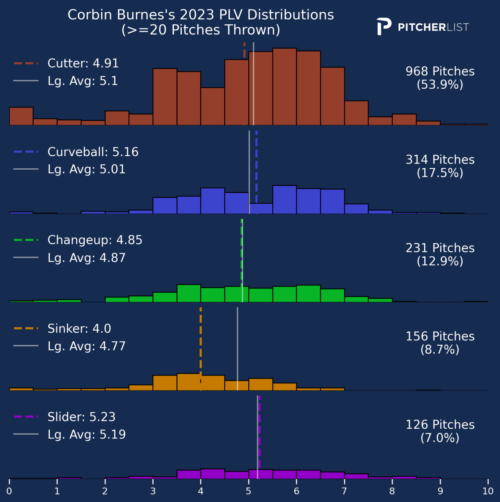
Last year, his cutter had significantly better pitch quality distributions. And that very much passes the eye test. If you’ve been reading Nick’s SP Roundups, then you know that we’ve really been waiting all year for his cutter to show the same sort of life as it did last season.
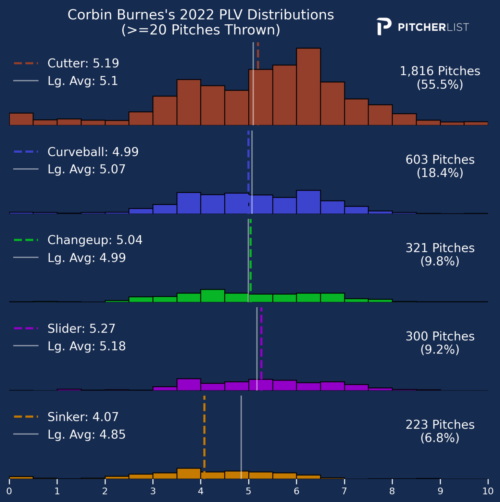
His K rate has declined this year by about five percent; however, his past two turns have concluded with double-digit strikeouts.
Against the Reds last Friday, it wasn’t the cutter, but rather the curveball, that stirred the drink. Burnes tossed a season-high 30 curveballs (29.4%), which returned a stellar 5.75 PLV / 1.73 PLA.
Yesterday against Philly, Burnes again went to the curveball a bunch (26%) and it paid dividends with a 61.5% CSW. However, despite the gaudy CSW, the curveball earned a relatively pedestrian 4.65 PLV / 3.73 PLA.
Instead, PLV actually liked his cutter better here as it earned an excellent 5.57 PLV / 1.68 PLA; That’s the second-highest grade we’ve seen from his cutter this season (4/11 @ ARI).
To be clear, I’m not sure there’s something to predict here, but I think it’s encouraging that Burnes’ two big strikeout performances were backed by impressive grades from his curveball and cutter.
The Pirates’ rookie catcher/outfielder is slashing .277 / .377/ .385 through his first 106 PA. Again, short sample size, but so far, he’s shown a passive approach at the plate (-6.0% swing aggression), which is also reflected to a degree by his above-average 11.3% BB rate.
Davis has also shown an impressive 18.9% K rate, which PLV backs with 60-grade contact ability. He’s also been above average in Decision Value (55); However, his power has been slightly below average (45).
McCormick has made waves with a 1.453 OPS over the last 15 days (nine games). Overall, he’s flashed impressive Decision Value (60) and Strikezone Judgement (55) with above-average power (55) that’s been peaking lately. Contact-ability (35) has been his one weakness.
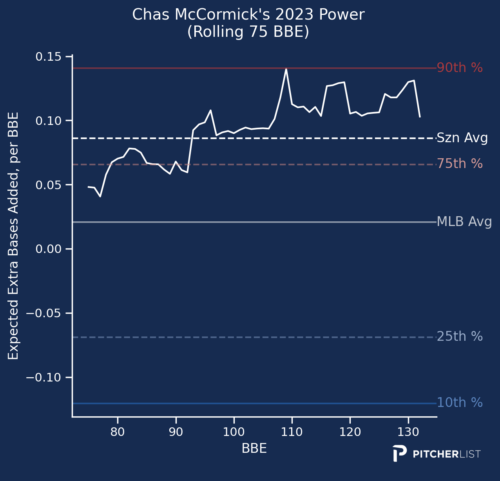
A former top prospect, Manning (526 total pitches, four starts) has been a mixed bag this year; The 3.37 ERA and 0.97 WHIP are great, but the 16.7% K rate makes me want to ignore it. Still, PLV really likes his slider; So far, it’s returned a 5.68 PLV / 1.72 PLA.
Scherzer bottled up a tough Dodger lineup and held them scoreless across seven in his latest outing; The start earned a 4.93 PLV and -5 hit luck (.067 BABIP), so it looks like there was some good fortune involved.
Overall, Scherzer’s K-BB% has declined from 26.4% to 20.8% and it looks like his slider might be the main culprit; Its chase rate and SwStr rate have plummeted from 48.5% and 26.7% to 37.2% and 17.4% respectively. Not only is he throwing his slider nearly 5% less frequently, but its pitch quality distribution has fallen back toward the league-average range.
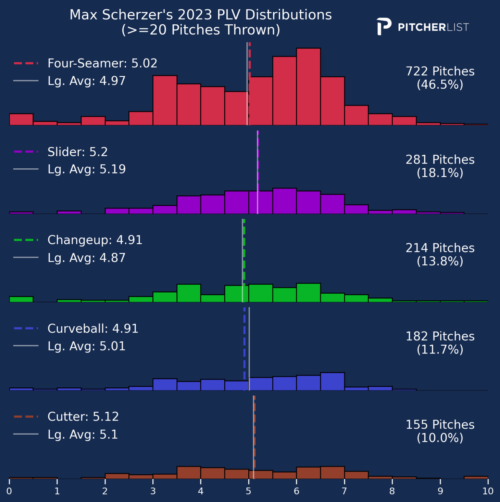
Wow, how about a 2.10 ERA and a 0.92 WHIP through your first nine starts? This past Thursday, he blanked the Giants through eight innings and allowed just two walks and one hit. The slider (28.3%) led the way and earned a 5.73 PLV / 1.80 PLA, the best grades we’ve seen from it so far.
Abbott doesn’t have high octane velocity, but his pitch quality distributions demonstrate just how exceptionally well he’s commanding both his breaking pitches. What a year it’s been for Reds fans.
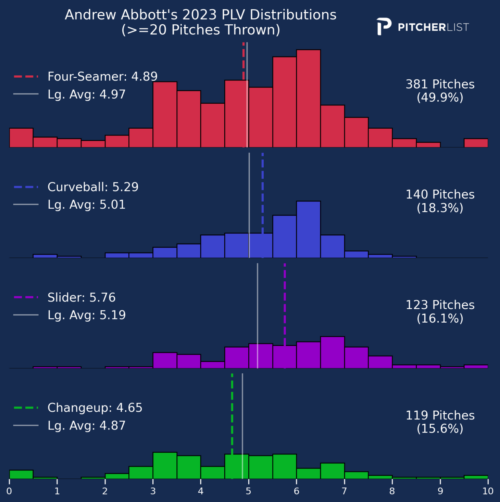
After having cleared Tommy John last year and an oblique injury that sidelined him through the first two months, Glasnow has been impressive. In his latest start, he held the Orioles to just two runs on six hits, and my favorite part, no walks. The outing earned a 5.52 PLV, the best we’ve seen from him so far.
Cillian Murphy’s doppelganger (fine, he’s about a foot taller, but still) has a 27.1% K-BB%, right about where he was two years ago.
His fastball isn’t quite where it was two years ago (5.34 PLV / 2.62 PLA vs. 5.09 PLV / 3.62 PLA) Although, on that note, his heater was really really good this past Thursday in that aforementioned start against the O’s and earned a 5.76 PLV / 1.72 PLA (36 pitches). That’s the best we’ve seen from the fastball this year.
We’ve also seen his slider perform noticeably better this year with a 5.46 PLV / 2.54 PLA as opposed to a 5.06 PLV / 3.39 PLA back in 2021.
Fernando Tatís Jr.
The .862 OPS would be a career-low, but Tatís Jr. has dropped his K rate from 28% in 2021 to 19.5% this year which is reflected by a bump in his contact-ability from 40 to 50.
Is MVP Bellinger back? I don’t know but, boy, this is some wild ride he’s on right now. As I’m writing this on Friday, he just hit another dinger.
I suppose you could look at Bellinger’s underwhelming power metrics (PLV still has him at 45 there, so below average). But even still, the man has a .375 wOBA, which would be 13th behind Louis Robert Jr. if he had enough at-bats to qualify. He’s now belted six home runs in 16 games this July with a 9% K rate. He’s quite literally off the charts right now.
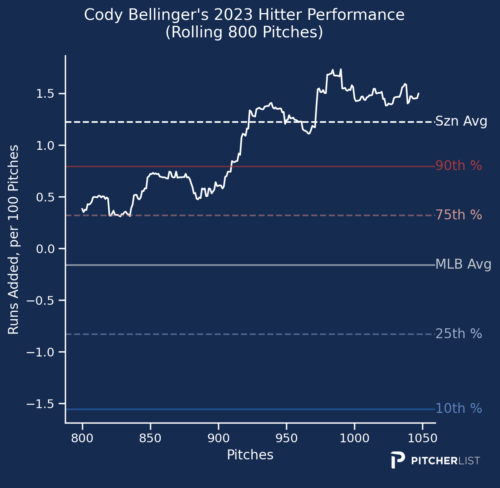
Silseth piled up a career-high ten strikeouts against the Yankees this past Wednesday. His slider earned a ridiculous ten whiffs on 15 swings en route to a 53.8% CSW on 39 pitches. However, it also earned a ho-hum 4.67 PLV / 4.44 PL. I’m inclined to think this had more to do with the Yankees doing what they’ve done most of the year, which is not hit a lick. Since June 4th (Aaron Judge’s last game was on June 3rd), they have a .291 team OBP, tied with the Tigers for second-worst in baseball.
The Nevada native and former Met continues to do his thing. This past Monday, he converted his 19th save. His 37.7% K rate is seventh among all qualified relievers, although I personally think Félix Bautista should be stricken from the record for making everyone else look bad. Regardless, Sewald’s 5.48 PLV currently leads all pitchers with at least 500 pitches thrown.


I’d like to petition that PLV be discontinued in favor of PLA. PLV is meaningless to me and probably most people. Do even the people who use it regularly really understand the difference between say a 5.12 and 5.17? If they do, its probably because they know how each point relates to PLA which is a measurement that all baseball fans understand.